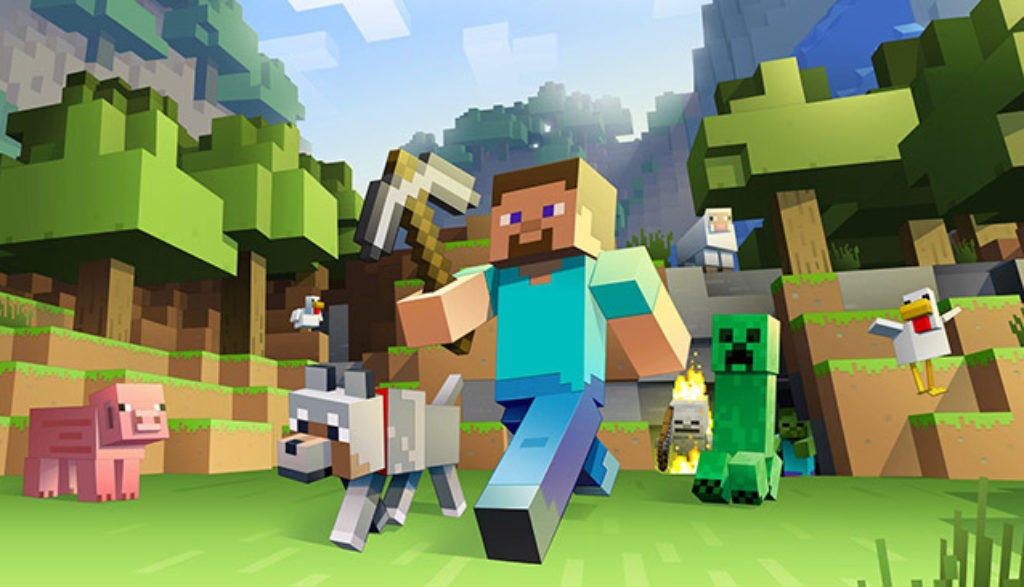
LEGOs and Lincoln Logs. Back when I was a kid—oh, a hundred years or so ago—those were the building blocks of dreams. With a big ol’ bucket full of interconnecting blocks or notched miniature logs, you could pretty much build whatever your imagination might dictate. Of course, the building joy was never limited to just kids. I’ve known adults who love building elaborate LEGO constructs and spend months on Lincoln Log cities.
All of that, of course, is now the low-tech stuff of yesteryear. If you really want unlimited inventive building in this day and age, there’s a hip virtual place to go where no bucket of blocks is required. It’s a video game called Minecraft, a title designed originally just for your PC, but which can now also be purchased for the Xbox and PlayStation consoles. And once this game latches on to your imagination, it grips tight!
Digging In
Getting started in the Minecraft world is relatively easy. Single-player gamers are plopped down in a randomly generated 3-D panorama of forests, mountain ranges, deserts, open golden plains or frigid ice fields. It’s a different-every-time biome that’s vast and pretty … and pretty primitive-looking since it’s all made out of virtual blocks. See what I mean? Even your own little avatar guy looks like he stepped out of an 8-bit game from oh so long ago.
As you slide into your avatar’s cube-ish shoes, though, you quickly realize that the undisturbed landscape around you is not meant to be left undisturbed. It’s not meant to be just looked at. It’s meant, instead, to be molded and shaped into pretty much anything you can dream up.
With a bit of experimentation you find that the blocky bits of the world can be broken down and turned into raw materials. And those raw materials can be used to build things. Start by chopping down a tree or digging up a chunk of ground, which will give you dirt, stone and wood that you can use to form rudimentary tools, which then help you more quickly break down and build things back up.
That sounds awfully basic, doesn’t it? But as you discover new resources, you also discover that the game’s crafting mechanic is a very complex system incorporating hundreds of different “recipes.” The right discovered combinations, laid out in a crafting table menu, can allow you to concoct incredible structures and mechanisms—from magic armor to intricate puzzle mazes to enormous castles with a moat and drawbridge.
Day and Night, Night and Day
Creative mode lets gamers get into the rhythm of digging down to richer resources, exploring caves, excavating mountainsides and developing the whole mix-and-match process of crafting. And the console games’ tutorial section helps flesh out all the many crafting possibilities. In this gaming mode, you can fly about and discover that certain rare minerals can help you shape more elaborate items like electric circuits, healing potions, powered carts or enchanted books that can give your tools and weapons some harder-to-break staying power. But truthfully, it’s Survival mode that’s the segment of the game where things start feeling like a—well, like a game. And this is the area where most players will gravitate.
Playing solo—or with up to seven other people on special PS4 or Xbox One online servers—you learn that building is still key, but now there’s a bit more challenge tossed into the mix. A day/night cycle exposes builders to varying stimulus, some of it good, some bad. Along with the regular critters that might be roaming the woods (such as sheep that can offer wool, chickens sporting feathers, or pigs and cows that can be brought down for meat and leather) there are predators afoot. Giant blocky spiders, growling zombies, exploding creepers and arrow-flinging skeletons are the sorts who generally stick to their dark caves during the day, but at night they wander the world freely.
You must begin thinking, then, about creating a shelter before the sun sets. You’ll need to craft a pickax and seek out some coal for a fire that’ll keep the beasties at bay while you cook up your meal. You’ll need to think about a sword or a bow with some arrows. A door might be a good thing. And how about mixing sand and fire for glass windows so you can see what’s outside? A hard-to-shamble-up stairway, maybe? Or how about stocking some regenerative food in a storage chest just in case you need an emergency boost?
What to Do When the Sun Goes Down
The baddies aren’t that scary, of course. They’re made of blocks, too, after all. But there is some bloodless battling if they catch you unawares in the dark. Smack them just the right way and they disappear in a blink of smoke. But if they land enough repeated blows, say, in the narrow confines of a darkened cave, the monsters can take you down to the point of death—where you lose all the crafting loot you may be carrying before you’re randomly regenerated somewhere out in that wide open world.
Those who stick with the block-building long enough will eventually discover that Minecraft holds other secret dimensions to explore. Once gamers find the enchanted bits to build special transporting portals (pieced-together contraptions that definitely require some rare ingredients) they can shoot through them to gather unique ores and supplies. One place you can go is called the Nether; it’s an underground dark land filled with rivers of flowing lava, magma monsters and zombie pigmen. It’s not quite a full-on representation of hell, but it’ll make you think about that kind of otherworldly locale, boasting, as it does, blocky witches and even a big boss Ender Dragon.
More than merely being a content concern, though, these dark-loving creatures serve something of a higher purpose here: spurring players to lend a little enhanced creativity to their crafting. To put a little figurative muscle to their building as the day turns to night. Of course that doesn’t completely erase them from the downside column, but it does smudge them up a bit.
It also helps point us away from the dark side, as it were, and toward the rampant creativity and unfettered imagination that rule this land. Rule it so rigorously that once you start poking around Minecraft’s secret nooks and crannies, building your first lava-spurting mega-fortress or figuring out how to stage your favorite Star Wars scene in 3-D block form, you may find that the months it takes to build a Lincoln Log city is … child’s play.
A postscript: The console versions of this game offer a wide variety of “textures” that can be purchased and layered over your play. A “festive” texture, for instance, offers up a Santa’s Village-like set of surroundings with lots of colored lights and bright gift wrap. Other possibilities, though, such as the Skyrim or Halo textures, have you mining and crafting in worlds that reflect the sights and sounds of popular M-rated video games (though they don’t incorporate the M-minded levels of messy content).

After spending more than two decades touring, directing, writing and producing for Christian theater and radio (most recently for Adventures in Odyssey, which he still contributes to), Bob joined the Plugged In staff to help us focus more heavily on video games. He is also one of our primary movie reviewers.